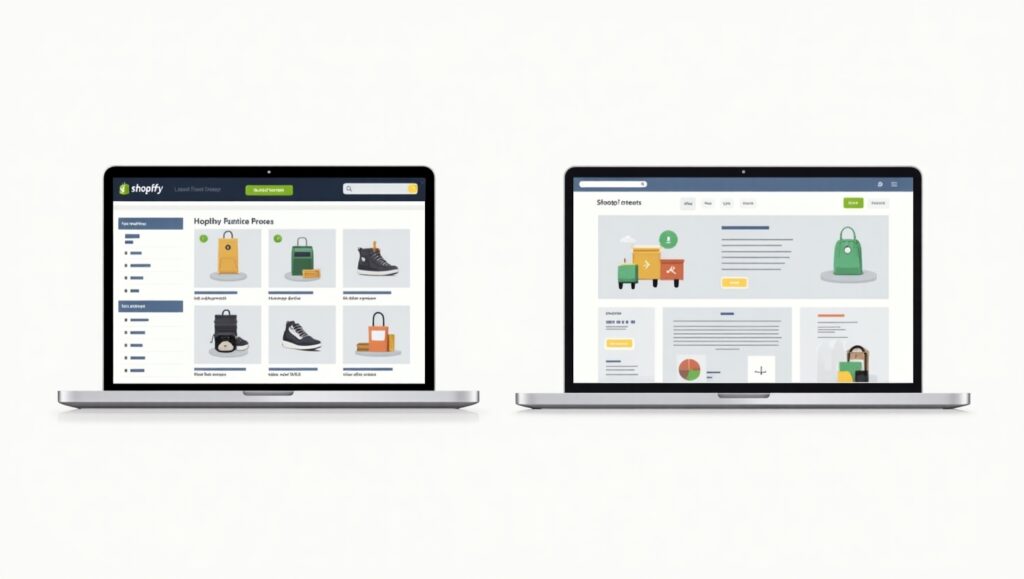Shopify has become one of the most powerful and accessible e-commerce platforms in the world. From garage startups to million-dollar brands, it’s the go-to choice for launching an online store. With over 4 million live Shopify stores as of 2025, it’s easy to understand the platform’s appeal—ease of use, beautiful themes, and powerful integrations. But despite its popularity, a surprising majority of Shopify stores end up failing.
This begs the question: Why do most Shopify stores fail, and what can you do to avoid the same fate?
Let’s break down the reasons behind this widespread issue and uncover solutions to help your store not just survive—but thrive.
The Harsh Reality: Shopify Store Failure Rate
It’s estimated that 90% of Shopify stores fail within the first 12 months. The reasons vary, but most often, failure comes down to poor planning, unrealistic expectations, and lack of follow-through. In e-commerce, failure means more than just shutting down a site. It includes stores with:
-
Zero or negative profit margins
-
High bounce rates and low customer retention
-
Inactive marketing strategies
-
Poor conversion rates
Understanding these indicators is the first step toward turning things around.
Lack of Market Research Before Launch
Many entrepreneurs launch their Shopify store based on a hunch, a trending TikTok product, or a viral post. But guessing is dangerous.
Thorough market research helps you:
-
Identify a hungry target audience
-
Understand your competition
-
Pinpoint gaps you can fill
Start with tools like Google Trends, Reddit forums, and competitor reviews. You’re not selling to everyone—you’re solving a problem for someone specific.
Poor Product Selection and Niche Confusion
Choosing the right product is everything. Mistakes include:
-
Jumping into overcrowded niches (e.g., generic fitness gear)
-
Selling fads instead of sustainable products
-
Offering too many unrelated items
A focused niche increases trust, makes marketing easier, and boosts conversions. Stick to evergreen products with consistent demand, or truly unique offerings with a clear audience.

Weak Branding and Store Design
Your Shopify store is your storefront. If it looks untrustworthy, cluttered, or outdated, customers leave within seconds.
Avoid:
-
Low-quality logos or generic names
-
Inconsistent color schemes and fonts
-
Hard-to-navigate layouts
Invest in a professional theme and create a visual identity that reflects your brand’s mission. First impressions are lasting.
Ineffective Product Descriptions and Imagery
Product pages should be sales tools, not placeholders. Instead of listing specs, focus on how the product improves the customer’s life.
Use:
-
Bullet points for clarity
-
Storytelling to connect emotionally
-
High-resolution, multiple-angle photos
If you’re using generic supplier photos or vague text, you’re likely losing customers by the second.
Neglecting Mobile Optimization
Over 70% of online shopping traffic comes from mobile devices. Yet many Shopify stores are built with desktops in mind.
Your mobile site must be:
-
Fast-loading
-
Easy to scroll and navigate
-
Touch-friendly with clickable buttons
Test every page on mobile. What looks sleek on desktop might be a mess on a smartphone.
Inadequate Pricing Strategies
Undercutting competitors isn’t always smart—it can cheapen your brand and shrink profits.
Use pricing models like:
-
Value-based pricing (charge based on the benefit to the customer)
-
Psychological pricing ($29.99 vs. $30.00)
-
Bundling to increase average order value
Also, don’t forget to account for ad costs, shipping, and fees in your pricing.
Failing to Understand Customer Psychology
Success in e-commerce means understanding human behavior. Proven triggers include:
-
Urgency (limited-time offers)
-
Scarcity (low stock warnings)
-
Social proof (customer reviews, testimonials)
-
Trust indicators (SSL badges, return policies)
Shopify apps can help automate these, but strategy is key.
Traffic Without Conversion Optimization
Getting visitors to your site is one thing. Getting them to buy is another.
To convert better:
-
Use clear CTAs (Call-to-Actions)
-
Show benefit-driven headlines
-
Add live chat or AI assistants
-
Simplify the checkout process (1-2 clicks max)
Don’t chase vanity metrics like pageviews—optimize for sales.
Over-Reliance on Paid Ads Without Strategy
Facebook and Instagram ads are not magic. Many stores burn through budgets without seeing a return.
Avoid this by:
-
Setting realistic ROI goals
-
Testing creatives and audiences
-
Using lookalike audiences and retargeting pixels
-
Monitoring metrics like CAC (Customer Acquisition Cost) and LTV (Lifetime Value)
Paid ads work—but only when part of a broader strategy.
No Retargeting or Email Marketing
70% of users abandon their carts, and most never return—unless you bring them back.
Use tools like:
-
Klaviyo or Omnisend for automated emails
-
Exit-intent popups
-
SMS follow-ups
Email isn’t dead—it’s your most profitable marketing channel if used right.
Poor Inventory and Fulfillment Management
Inventory issues are one of the fastest ways to ruin a customer’s trust. If a buyer orders an item only to receive a delay notification—or worse, a cancellation—you’ve lost more than just a sale.
Common pitfalls include:
-
Relying on unreliable dropshipping suppliers
-
Not syncing inventory across platforms
-
Poorly estimated shipping times
Consider using Shopify’s inventory management tools or integrate with apps like Oberlo, DSers, or ShipStation. Always be upfront about shipping times and provide tracking updates to reduce anxiety for the buyer.
Ignoring Customer Service and Support
Online shoppers expect fast, personalized support. Failing to deliver can lead to bad reviews, refund requests, and abandoned carts.
Best practices include:
-
Using live chat (via apps like Tidio or Gorgias)
-
Responding to emails within 24 hours
-
Offering easy returns and exchanges
Remember, great customer service turns one-time buyers into lifelong customers.
Lack of Patience and Unrealistic Expectations
Many Shopify store owners fall for the myth of instant success. Viral TikTok videos may show “overnight millionaires,” but most don’t share the months (or years) of hard work behind the scenes.
Understand that:
-
Results take time—especially organic growth
-
Testing and optimizing is part of the journey
-
Every failed ad or product is a learning opportunity
Instead of quitting after two weeks, aim to improve steadily over months.
Tools and Apps That Can Help Prevent Failure
Shopify has a rich ecosystem of apps and tools designed to help store owners at every stage. Here are some essentials:
| Category | Recommended Apps |
|---|---|
| Email Marketing | Klaviyo, Omnisend |
| Reviews & Social Proof | Loox, Yotpo |
| Conversion Optimization | Privy, Optimonk, Hotjar |
| Abandoned Cart Recovery | ReConvert, SMSBump |
| Customer Support | Gorgias, Zendesk |
| Analytics | Google Analytics, Triple Whale |
These tools can automate tasks, provide insights, and enhance customer experience—if used wisely.
Proven Strategies to Build a Successful Shopify Store
Avoiding failure is only half the battle; building a winning store requires proactive strategy.
Here’s what works:
-
Brand Consistency: From logo to tone of voice, make your brand memorable.
-
High-Quality Content: Blog posts, guides, and videos drive organic traffic.
-
Email Funnels: Guide new visitors from welcome emails to purchase with automated sequences.
-
Influencer Marketing: Partner with micro-influencers for credibility and reach.
-
Customer Feedback Loops: Use reviews and surveys to improve your product and service continuously.
Success isn’t just about avoiding mistakes—it’s about doubling down on what works.
Final Thoughts on Avoiding Shopify Failure
There are countless Shopify success stories—but they didn’t happen by accident. Most of them involved persistence, trial and error, and a whole lot of learning.
To avoid becoming just another failure statistic:
-
Do your homework before launching
-
Focus on solving problems for a specific audience
-
Keep improving your store, marketing, and customer experience
There’s never been a better time to start a Shopify business—as long as you do it smartly.
FAQs About Why Most Shopify Stores Fail
What’s the #1 reason most Shopify stores fail?
Lack of proper market research. Many stores jump in without knowing their target audience or validating product demand.
Can you make money dropshipping on Shopify?
Yes, but only with a strategic approach—good supplier relationships, fast shipping, and effective marketing are essential.
How much money do I need to start a successful Shopify store?
At minimum, expect to invest $300–$1,000 for basic setup, branding, and testing initial ads or SEO content.
How long before a Shopify store becomes profitable?
It varies—some take weeks, others months. With consistent effort, most stores see traction within 3–6 months.
Is SEO important for Shopify?
Absolutely. SEO brings long-term, sustainable traffic and reduces reliance on paid ads.
What’s the best way to market a new Shopify store?
Start with content marketing, influencer collaborations, and email list building. Then test paid ads once your funnel is optimized.



